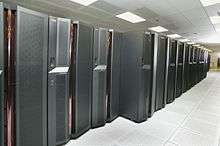Advanced Simulation and Computing Program
The Advanced Simulation and Computing Program (or ASC) is a super-computing program run by the National Nuclear Security Administration, in order to simulate, test, and maintain the United States nuclear stockpile.[1] The program was created in 1995 in order to support the Stockpile Stewardship Program (or SSP). The goal of the initiative is to extend the lifetime of the current aging stockpile.
 | |
| Public | |
| Founded | 1995 |
| Headquarters | |
History
After the United States' 1992 moratorium on live nuclear testing, the Stockpile Stewardship Program was created in order to find a way to test, and maintain the nuclear stockpile. In response, the National Nuclear Security Administration began to simulate the nuclear warheads using supercomputers. As the stockpile ages, the simulations have become more complex, and the maintenance of the stockpile requires more computing power. Over the years, due to Moore's Law, the ASC program has created several different supercomputers with increasing power, in order to compute the simulations and mathematics.
Research
The majority of ASC's research is done on super-computers in three different laboratories. The calculations are verified by human calculations.
Laboratories
The ASC program has three laboratories:[2]
Computing
Current supercomputers
The ASC program currently houses two supercomputers on the TOP500 list for computing power. The Sequoia, which as of 2016 was ranked third[3] in the world for computing power, is currently being used for simulation and testing in the Lawrence Livermore National Laboratory.[4] Cielo, which is also located in Los Alamos National Laboratory, is 57th on the TOP500 list for most powerful computer as of 2016. Cielo is researching classified information. Although these computers may be in separate laboratories, remote computing has been established between the three main laboratories.
Previous supercomputers

- ASCI Q: Installed in 2003, it was a DEC AlphaServer SC45/GS Cluster and reached 7.727 Teraflops.[5][6] ASQI Q used DEC Alpha 1250 MHz (2.5 GFlops) processors and a Quadrics interconnect. ASCI Q placed as the 2nd fastest supercomputer in the world in 2003.[7]
- ASCI White
- ASCI Red
- ASCI Purple
- ASCI Blue Pacific
- ASCI Blue Mountain
- Red Storm
- Blue Gene
Elements
Within the ASC program, there are six subdivisions, each having their own role in the extension of the life of the stockpile.
Facility Operations and User Support
The Facility Operations and User Support subdivision is responsible for the physical computers and facilities and the computing network within ASC. They are responsible for making sure the tri-lab network, computing storage space, power usage, and the customer computing resources are all in line.[8]
Computational Systems and Software Environment
The Computational and User Support subdivision is responsible for maintaining and creating the supercomputer software according to NNSA's standards. They also deal with the data, networking and software tools.[9]
The ASCI Path Forward project substantially funded the initial development of the Lustre parallel file system from 2001 to 2004.[10][11]
Verification and Validation
The Verification and Validation subdivision is responsible for mathematically verifying the simulations and outcomes. They also help software engineers write more precise codes in order to decrease the margin of error when the computations are run.[12]
Physics and Engineering Models
The Physics and Engineering Models subdivision is responsible for deciphering the mathematical and physical analysis of nuclear weapons. They integrate physics models into the codes in order to gain a more accurate simulation. They deal with the way that the nuclear weapon will act under certain conditions based on physics. They also study nuclear properties, vibrations, high explosives, advanced hydrodynamics, material strength and damage, thermal and fluid response, and radiation and electrical responses.[13]
Integrated Codes
The Integrated Codes subdivision is responsible for the mathematical codes that are produced by the supercomputers. They use these mathematical codes, and present them in a way that is understandable to humans. These codes are then used by the National Nuclear Society Administration, the Stockpile Steward Program, Life Extension Program, and Significant Finding Investigation, in order to decide the next steps that need to be taken in order to secure and lengthen the life of the nuclear stockpile.[14]
Advanced Technology Development and Mitigation
The Advanced Technology Development and Mitigation subdivision is responsible for researching developments in high performance computing. Once information is found on the next generation of high performance computing, they decide what software and hardware needs to be adapted in order to prepare for the next generation of computers.[15]
References
- "Advanced Simulation and Computing and Institutional R&D Programs | National Nuclear Security Administration". NNSA. Retrieved 2016-01-31.
- "Sandia National Laboratories: Advanced Simulation and Computing". www.sandia.gov. Retrieved 2016-01-31.
- "November 2015 | TOP500 Supercomputer Sites". www.top500.org. Retrieved 2016-01-31.
- "ASC Sequoia". asc.llnl.gov. Retrieved 2016-01-31.
- Los Alamos National Laboratories (2002). "The ASCI Q System: 30 TeraOPS Capability at Los Alamos National Laboratory" (PDF). Archived from the original (PDF) on 2011-01-12. Retrieved 2010-06-06.
- High performance scientific and engineering computing: hardware/software support by Laurence Tianruo Yang 2003 ISBN 1-4020-7580-4 page 144
- TOP500 Rankings
- "Facility Operations and User Support | National Nuclear Security Administration". NNSA. Retrieved 2016-01-31.
- "Computational Systems & Software Environment | National Nuclear Security Administration". NNSA. Retrieved 2016-01-31.
- Gary Grider (2004-05-01). "The ASCI/DOD Scalable I/O History and Strategy" (PDF). University of Minnesota. Retrieved 2016-12-08.
- R. Kent Koeninger (2003-06-01). "The Ultra-Scalable HPTC Lustre Filesystem" (PDF). Linux Cluster Institute. Retrieved 2016-12-08.
- "Verification & Validation | National Nuclear Security Administration". NNSA. Retrieved 2016-01-31.
- "Physics and Engineering Models | National Nuclear Security Administration". NNSA. Retrieved 2016-01-31.
- "Integrated Codes | National Nuclear Security Administration". NNSA. Retrieved 2016-01-31.
- "Advanced Technology Development and Mitigation | National Nuclear Security Administration". NNSA. Retrieved 2016-01-31.